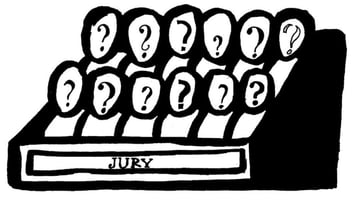February 19, 2019
Mastering Group Voir Dire: Tip 10—Don’t Let Jurors Hide

So far, our Tips series has focused on setting the stage for effective voir dire (Tip 1; Tip 2; and Tip 3), capitalizing on open-ended questions to increase our understanding of jurors (Tip 4), avoiding the “looking good” bias (Tip 5), crafting questions with the “bad” answer in mind (Tip 6), using questions that contrast viewpoints or positions (Tip 7), the need to intersperse majority response questions to foster continued participation (Tip 8), and using the springboard method to encourage participation (Tip 9). Our next tip addresses the silent or “hiding” juror who seeks to avoid participation during voir dire. (Click here to see a short video for this tip.)
Silence is Not Golden
Juror nonparticipation during group questioning is a major problem and strikes at the very foundation of effective voir dire. Without juror participation, voir dire becomes meaningless. Of course, jurors may be “silent” for a number of reasons, some good (e.g., no answer is appropriate from the jurors) and some not so good (e.g., nervous about speaking up, unsure about the applicability of their answer, or even wanting to hide information from the attorney). Research shows that jurors are not necessarily forthcoming in answering group voir dire questions, both in research testing different questioning techniques and in research examining responses to subsequent follow-up questioning of those jurors failing to participate (termed “silent” jurors) in judge-conducted-only questioning. In fact, this latter study found that while 28% of jurors were “silent” during the standard questioning, 17.5% of these “silent” jurors revealed relevant information when specifically asked why they had not answered any questions. Subsequent juror revelations ranged from contacts with law enforcement and biases for or against law enforcement to a potential juror being the fiancée of the defendant.
On a number of occasions, attorneys have asked what to do with jurors who do not participate in voir dire, often in the context of these “silent” jurors not being so silent during subsequent deliberations. My response is the same, “Who is in charge of voir dire?” The answer, of course, is the attorney (provided it is not a judge-conducted-questioning only jurisdiction). It is important to recognize that just because potential jurors don’t say anything or fail to participate during voir dire, this does not mean that they don’t harbor adverse opinions or that they have not had experiences causing them to be unfavorable to your client. It means only that you do not know whether they do or not. There is an additional danger to the presence of silent jurors; the strategy that allows the silent juror to remain silent also increases the potential nonresponsiveness of other jurors. There are several approaches that are helpful in addressing the silent juror.
Recognize the Situation
While it may seem obvious, the first step in addressing the silent juror(s) is to recognize the situation when it arises. Oftentimes, attorneys only recognize the silent juror at the end of voir dire, when they see that one or more jurors have not participated. In part, this may be because of the tendency to focus on those jurors who are participating and assuming that those jurors participating are the only relevant ones. One way to prevent this form of “tunnel vision” is to have a goal of making sure you find out something from every juror. With this objective in mind, you are better able to identify the situation early in the questioning process.
Engage the Silent Juror
Once a juror has been identified as silent or in some other way not participating in voir dire, it is important to seek to engage the juror. In earlier tips, I addressed what can be termed “process barriers” that inhibit juror participation. That is, is there something in the way that voir dire is being conducted that fosters silence on the part of some or many jurors? Counteracting the process barriers to participation is a necessary first step. Employing the initial background summary approach (Tip 2) or the initial hand-raising technique (Tip 3) encourages participation at the beginning of voir dire, while interspersing majority response questions (Tip 8) and using the springboard method of questioning (Tip 9) fosters continued participation.
Don’t Make Participation Optional
Oftentimes in group voir dire questioning, attorneys ask questions that tend to be one-sided or are likely to be answered by a minority jurors. Consider the following questions:
“How many of you have any negative feelings toward corporations?”
Or
“How many of you have been a victim of a crime?”
Both questions get at important information, but notice that they either set up a minority response or allow the jurors to remain silent even if an answer should be given. Participation becomes optional. However, if you change the format of the question or the relatedness of a series of questions, you can make participation mandatory for all jurors. A number of changes can be made to draw out the silent or “hiding” juror.
Balance the question. When you choose to ask one-sided questions, the silent or “hiding” juror has an opportunity to remain silent by just not participating. Asking a question that addresses both or multiple sides of an issue will force participation by all jurors, including the silent ones. Consider the following approaches:
“Let’s turn now to the topic of corporations and how we view them. In general, how many of you have any negative feelings toward corporations? (But don’t stop there . . .)
“In general, how many of you have any positive feelings toward corporations?”
Or, if you are concerned with not alerting the opposition to “favorable” jurors:
“In general, how many of you do not have any negative feelings toward corporations?”
<Jurors who fail to raise their hand by the end of the questions are directly asked for their views on the matter.>
Contrast competing positions. A similar approach is to ask a question that contrasts competing positions (Tip 7). By contrasting positions in the same question, you force the silent juror to participate. In essence, there is no place to hide, as illustrated in the following approach.
“There are several views on providing money for pain and suffering. Some jurors feel that little or no money should be given for emotional suffering because it does not make the emotional suffering go away. Other jurors feel that money should be given for emotional suffering reflecting the amount of this suffering. I would like to know which of these views is closer to your own.
“How many of you feel that little or no money should be given for emotional suffering because it does not make the emotional suffering go away?
“How many of you feel that money should be given for emotional suffering reflecting the amount of this suffering?”
<Again, jurors who fail to raise their hand by the end of the questions are directly asked for their views on the matter.>
Flip the question. Another approach to making participation mandatory is to “flip” the question from a minority response to a majority response question—with a little twist. Ask the majority response question and then follow up with jurors who do not raise their hands. Consider the following adaptation to the “victim of crime” question.
Attorney:
How many of you HAVE NOT been a victim of a crime?<A majority of jurors raise their hands. However, silent juror, Mr. Jones, along with a few other jurors, did not raise his hand.>
Attorney:
“Mr. Jones, I see that you have been a victim of a crime. Could you tell me about your experience?”Mr. Jones:
“I’m sorry. I was distracted and didn’t raise my hand. I haven’t been a victim of a crime.”Attorney:
I understand. I am sure I’ll get a chance to talk with you a little later.”<The silent/hiding juror has learned two things: 1) he will not be able hide by “not participating,” and 2) he will be speaking with the attorney in the future. Of course, you need to follow up on this “promise.”>
Be direct. While the above approaches are good, the most effective way to address silent or hiding jurors is to be direct. Once you have identified the silent or hiding jurors, or simply jurors who are reluctant to participate, make a point of addressing them directly. This can be accomplished in a nonconfrontational and supportive manner.
Attorney:
<Introduction is given to the topic of pain and suffering. > Now, Mr. Jones, we haven’t heard from you yet. Would you tell me your views on providing money damages for the pain and suffering caused by the negligence of another?Mr. Jones:
That’s a hard one . . . but I am not really comfortable with giving money to someone for that since money can’t really take away the pain.”Attorney:
Thank you. I appreciate your candor. Let’s talk about that a little more . . .”
The direct approach is a flexible tool. It can be employed at the beginning of a topic area, much like in the springboard method (Tip 9), or it can be used at any time during the questioning process.
Don’t Let Jurors Hide
Silent or hiding jurors pose a difficult challenge to your voir dire and jury selection success. Not only do they inject uncertainty and, potentially, bias into the selection process but also their nonparticipation can lower the participation rates of the other jurors being questioned. Intervening early with silent or hiding jurors sets the tone for what is expected during voir dire. Each of the above approaches enables you to uncover and effectively address silent or hiding jurors. The key to this—and a key to effective voir dire—is to not let jurors hide or avoid participation. It is only through maximizing participation from all jurors that you have the basis for effectively exercising challenges for cause and peremptory challenges.
Our next tip will continue examining juror participation during group questioning by giving jurors a second chance to participate in the questioning process. We will be covering additional tips in the months to come. Check out our introductory two-minute video, Tip 1, Tip 2, Tip 3, Tip 4, Tip 5, Tip 6, Tip 7, Tip 8, Tip 9, and the video for Tip 10.
For more information on voir dire and jury selection, see Mastering Voir Dire and Jury Selection: Gain an Edge in Questioning and Selecting Your Jury, Fourth Edition (2018). Also, check out my companion book on supplemental juror questionnaires, Mastering Voir Dire and Jury Selection: Supplemental Juror Questionnaires (2018).
Available podcasts:
On January 25, 2019, Dr. Frederick presented a CLE program entitled “Mastering Voir Dire and Jury Selection” at the ABA Midyear Meeting at Caesar’s Palace in Las Vegas. Legal Talk Network conducted a short, 10-minute interview in conjunction with this program. You can listen to this podcast at: https://legaltalknetwork.com/podcasts/special-reports/2019/01/aba-midyear-meeting-2019-mastering-voir-dire-and-jury-selection/.
Dr. Frederick presented a 60-minute program based on his book, Mastering Voir Dire and Jury Selection: Gain an Edge in Questioning and Selecting Your Jury, for the ABA Solo Small Firm and General Practice Division’s November 21, 2018 session of Hot Off the Press telephone conference/podcast. Check it out at the Hot Off the Press podcast library at: https://www.americanbar.org/groups/gpsolo/events_cle/gpsolo-podcasts/2018-podcast-library/



